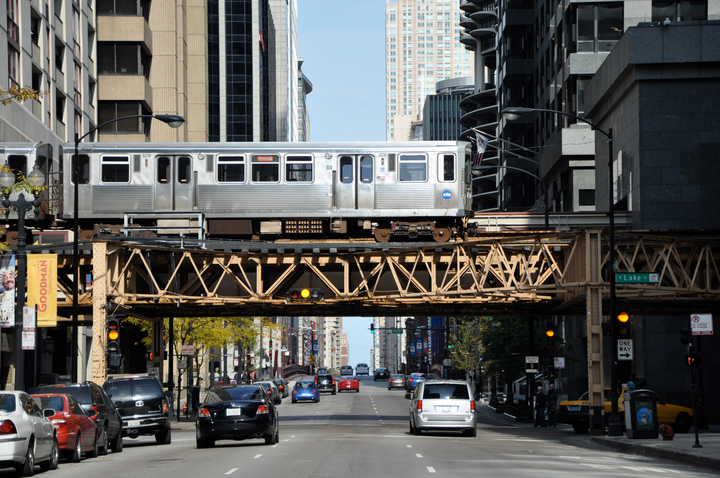Our region’s transit system is facing a pivotal moment.
While ridership is on the rebound from pandemic lows, service is not meeting rider needs and the system is heading towards a significant fiscal cliff.
If you’re frustrated with transit service now, be warned that it will be far worse if this funding gap is not addressed. If we don’t intervene, our local transit systems will need to make drastic cuts that could be along the lines of:
- Four out of eight CTA train lines.
- 90 out of 129 CTA bus routes.
- 70 out of 210 Pace bus routes.
- Six out of 11 Metra lines.
And we have to keep front and center the reality that if the region’s transit system is hobbled even further, the brunt of the effects would be felt by the most vulnerable groups — seniors, households with low incomes, people who are unable to drive due to a disability, and communities of color.
How did we find ourselves here, at this corner that once had a bus stop? Waiting on a platform for a train that comes at most every 15 minutes during the day? At a Metra station with no way to reach the job site 3 miles away?
While this crisis has been decades in the making, to be sure, the pandemic certainly accelerated the process. Here’s some background about how we’ve reached this point:
- The federal government by and large does not provide funding for transit operations.
- The state of Illinois only kicks in 17 percent of our region’s operating funds, far below what other states contribute to urban-area transit systems.
- Residents of the Chicago region chip in the greatest portion of local transit funding through a sales tax on goods and through rider fares – two sources that vary considerably based on economic conditions, and, as we have learned, during a pandemic.
- We currently are bound to an untenable fare box recovery ratio that far exceeds that of other transit systems and leads system operators to make service decisions based on route revenues rather than need.
Exacerbating all this is a convoluted 40-year-old governance structure comprised of four agencies, four boards of directors, outdated funding formulas, a lack of regional service planning, multiple fare structures, and so on.
Each board is tasked with managing its own bottom line/farebox recovery requirement instead of focusing on the needs of all riders in the region. Since 2013, no fewer than four independent reports have called for reforming the local governance structure.
So where do we go from here?

In 2022, state legislators started laying the groundwork to address the coming funding gap. They passed legislation that directed the Chicago Metropolitan Agency for Planning (CMAP) to produce new recommendations for the following:
- The fare box recovery ratio.
- Sales tax formula and distributions.
- Governance structures.
- Regional fare systems.
According to the legislation, the recommendations should create a plan for “long-term financial viability of a comprehensive and coordinated regional public transportation system that moves people safely, securely, cleanly, and efficiently and supports and fosters efficient land use.”
The result was the extensive Plan of Action for Regional Transit, which is supported by a series of deep dives that address the issues and solutions. The plan is divided into three sets of recommendations:
- The Transit System We Want, which outlines critical service improvements.
- How to Pay For it, which explores a range of revenue options and principles.
- How to Implement It, which charts a new vision for regional governance.
Our Executive Director Amy Rynell served on the Plan of Action steering committee and helped lead the creation of The System We Want alongside other leaders from the business, labor, community, and civic sectors.
While the fiscal cliff may have launched these efforts, we cannot simply fill the financial gap and continue on with the system that we have today – a struggling system not meeting many riders’ needs. The better and more responsive the service, the more riders it will attract.
Recommendations we advanced included restoring and investing in transit service, fare integration and fare levels, better buses, regional rail, full system accessibility, safety and security, and transit-supportive land use and development.
The Plan of Action for Regional Transit will soon be handed off to Governor Pritzker and state legislature for action. They will be deciding the policies that will either support a robust, fiscally stable transit system of the future, or reinforce the status quo of inequitable unstable funding, lackluster service, and inefficient structure.
We are all in on this journey. Meaningful transit investment will reduce greenhouse gas emissions and mitigate climate change. Strong transit is a powerful tool to make the region and state more attractive to investment and to boost economic health. A stronger transit system will enable equitable access to opportunities for all.
We will need our members and supporters at the ready to ask their state senators and representatives for policy solutions to create the most equitable and robust system.
We will keep you informed on ways to take action and make your voice heard.
We cannot overstate what a pivotal moment it is for the future health of our region’s transit system. We will need all of us on board for this fight.
Active Transportation Alliance Executive Director Amy Rynell recently participated in a webinar focused on how transit advocates are raising awareness and persuading legislators to take dramatic actions to address the urgent needs facing their transit systems. Listen here.
This post was written by Amy Rynell and Active Transportation Alliance Advocacy Manager Julia Gerasimenko.
Second photo down shows Active Transportation Alliance Advocacy Manager W. Robert Schultz III at a recent legislator briefing in Springfield speaking with Rep. Lilian Jiménez, who represents Illinois’ 4th District, which includes parts of the Chicago neighborhoods of Austin, Belmont Cragin, Hermosa, Humboldt Park, and West Town.

